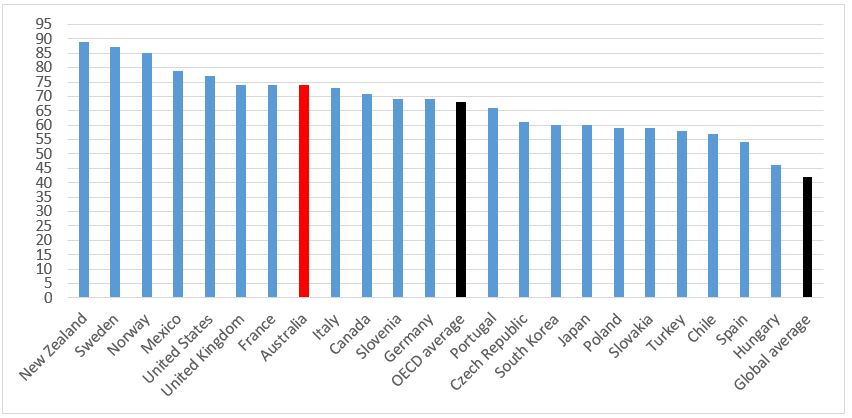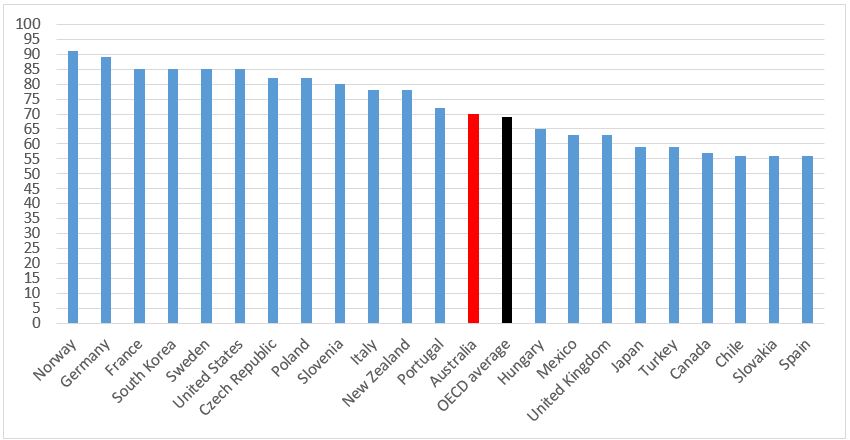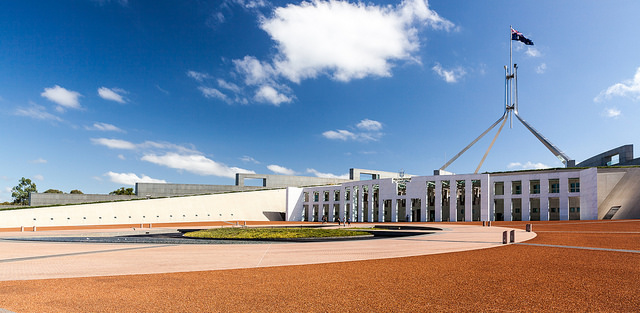This two-part series about the Open Budget Index (OBI) presents budget transparency results for Australia in this global budget survey initiative. Part 1 explains what the OBI is and presents the key findings from the Australian Open Budget Survey 2017. Part 2 focuses on how we could improve Australia’s budget transparency and accountability, and discusses the OBI findings for budget transparency around the world.
Why open budgets?
The government budget is a central political process where taxing and spending decisions are made, affecting everyone in a society. Civil society organisations are increasingly advocating for more transparency of government budgets. This is an extension of the broader struggle to make governments more open and accountable to citizens, improve financial integrity and stop corruption, the aim of leading non-government organisation Transparency International.
Open budgets should improve fiscal decision making, make corruption more difficult and taxing and spending fairer and more effective.
The Open Budget Index
In 2006, the Centre on Budget and Policy Priorities, a US based NGO, launched an International Budget Partnership aimed at opening budgets around the world to public scrutiny. Every two years, it publishes an Open Budget Index (OBI), aimed at assessing and improving budget transparency, oversight and participation.
The OBI ranks countries using a transparency score, which is based on a Survey for each country about publishing of budget documents, budget oversight, and public participation. The Surveys, and rankings, are available at the International Budget Partnership website.
This year, there were 115 countries in the OBI, 13 more than in the past. For the first time, an Australian Survey was completed by the Tax and Transfer Policy Institute (TTPI) at the ANU. Each country’s Survey for the OBI is prepared independently by an in-country civil society organisation or academic researcher, using standardised questions and based on evidence. The assessments are reviewed anonymously. All comments are publicly available on the IBP website.
Australia scores well on budget transparency
In our first Survey, Australia received a score of 74 out of 100 and a ranking of 12th in the OBI. Australia’s score of 74 is substantially higher than the global average of 42 and also higher than the OECD average of 68 (22 OECD countries participated in the Survey). But Australia lags behind our neighbours New Zealand and also behind the US, UK and France. The top three countries in the OBI are New Zealand (score: 89), South Africa (score: 89) and Sweden (score: 87).
Figure 1: Open Budget Index 2017 – comparison with OECD countries and global average
 Source: IBP 2018
Source: IBP 2018
Note: Scores of 81-100 indicate provision of extensive budget information, 61-80 indicate substantial budget information, 41-60 indicate limited budget information, 21-40 indicate minimal budget information and 0-20 indicate scant budget information.
The Survey assessed Australian federal budget process for the 2015-2016 year (and the first half of the 2016-2017 year). Australia’s government performs well in publishing most budget documents at different points in the budget process. These include:
- Executive’s Budget Proposal (score: 87 out of 100);
- Mid-Year economic and Fiscal Outlook (MYEFO) report (score: 93);
- Commonwealth Monthly Financial Statements or In-Year Reports (score: 70);
- Budget Outcome or Year-End Report (score: 64);
- Audit Report by the Australian National Audit Office (score: 81).
These are the areas where Australia made substantial reform in the 1990s with the introduction of the Charter of Budget Honesty.
However, the Australian government performs less well for other key documents. It does not publish a Pre-Budget Statement (score: 0, as pre-budget documents are produced only for internal use of the government), and publishes less information in the Enacted Budget (the Appropriation Acts, score: 39) and the Citizens Budget (A simpler and less technical version of the government’s budget proposal and other budget documents, score: 50). Australia also lags behind New Zealand in transparency of most reports.
Figure 2: How comprehensive is the information provided in the key budget documents? Comparison between Australia and New Zealand
 Source: IBP 2018
Source: IBP 2018
Note: Scores of 81-100 indicate provision of extensive budget information, 61-80 indicate substantial budget information, 41-60 indicate limited budget information, 21-40 indicate minimal budget information and 0-20 indicate scant budget information.
Public participation
Public participation is the weakest link in Australia’s budget transparency and accountability. We score only 41 out of 100, indicating limited opportunities for the public to engage in the budget process.
Yet, participation opportunities are much scarcer in most other countries in the world. Australia is in fact one of the top performers in the OBI on participation. Almost all countries have only scant opportunities for public participation (score 40 and below). New Zealand, the United Kingdom, Australia and the Philippines are exceptions. Figure 3 presents the participation scores for OECD countries.
Figure 3: Public participation – comparison with OECD countries and global average
 Source: IBP 2018; OECD average is authors’ own calculation.
Source: IBP 2018; OECD average is authors’ own calculation.
Note: Scores of 61-100 indicate adequate public participation opportunities, 41-60 indicate limited opportunities and 0-40 indicate few or no opportunities.
Budget oversight and audit
While public accounting might seem a very dry topic, audit and public reporting of revenues and expenditures is essential for open and accountable budgets. Australia receives a good score of 70 out of 100. Figure 4 compares Australia’s budget oversight score with other OECD countries. Australia’s score is just slightly above the OECD average of 69 and far behind Norway (score: 91), which tops among the OECD countries.
Figure 4: Budget oversight – comparison with OECD countries
 Source: IBP 2018; OECD average is authors’ own calculation.
Source: IBP 2018; OECD average is authors’ own calculation.
Note: Scores of 61-100 indicate adequate oversight, 41-60 indicate limited oversight and 0-40 indicate weak oversight.
Australia’s independent financial oversight by the ANAO as the supreme audit institution is very strong (score: 100). But Australia presents a mixed picture on legislative oversight of the budget – even though budget debates are highly political. The Parliament provides adequate oversight at the executive and audit stage (score: 67); but limited oversight at the formulation and approval stage for the budget (score: 48).
The main barrier to effective legislative oversight is the lack of pre-budget debate by the parliament, the Executive’s Budget Proposal provided to members of parliament less than two months before the start of the budget year, and in-year budget implementation not examined by a parliamentary committee.
The score does not account for a recent innovation in Australia: the Parliamentary Budget Office (PBO) established in 2012. The PBO makes an important contribution as an independent fiscal institution. This is not counted in the final score of budget oversight. The PBO’s function include providing policy costings to all parliamentarians and conducting research and analysis of budget and fiscal policies.
Good but room to improve
The budget is where the “rubber hits the road” for government policy. It is crucial that budget processes are fair, open, democratic and accountable. Australia performs well on budget transparency – as we should expect as citizens in a robust parliamentary democracy.
But there are some gaps in the Australian budget system and it’s important for us to keep an eye on transparency and pursue increased public reporting, analysis and participation in the budget process.
Further readings: Australia country report | Global report | Rankings | Results by country | Data explorer
Open Budget Survey 2017 Part 2: What Can Australia Do to Improve our Budget Process? By Miranda Stewart and Teck Chi Wong
A Speech by the Parliamentary Budget Officer: Fiscal Transparency and the Parliamentary Budget Office, by Jenny Wilkinson
Podcast






Pingback: A Speech by the Parliamentary Budget Officer: Fiscal Transparency and the Parliamentary Budget Office - Austaxpolicy: The Tax and Transfer Policy Blog
Pingback: Open Budget Survey 2017 Part 2: What Can Australia Do to Improve our Budget Process? - Austaxpolicy: The Tax and Transfer Policy Blog
Pingback: Budget Forum 2018: Should Australia produce a Citizen’s Climate Budget? - Austaxpolicy: The Tax and Transfer Policy Blog